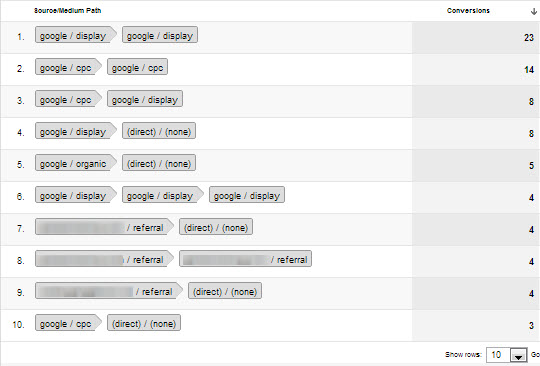Knowing where to invest your marketing dollars across a wide range of student recruitment strategy and tactics for the highest return on investment is key to meeting your institution’s enrollment objectives. You rely on your experience and your team’s expertise to make these decisions but if you are typical there’s likely still quite a bit of subjective, qualitative analysis (or some might call intuition, others guessing) going on. And by the way, that’s pretty normal in any marketing department unless you are already heavily analytics driven.
An even more complicated dimension to try and wrap your head around is the interaction of all of your marketing elements with each other. The aggregate effect of your marketing mix is greater than the individual parts but determining which parts are most critical to your success is a very difficult question to answer.
Limited resources often force you to pick and choose between them without having a completely clear picture of what impact to expect. Multi-channel funnels and conversion attribution are processes that break down these channels and then measure the interactions between them to answer these questions. Searchengineland.com defines conversion attribution as, “the science of calculating the contribution that each marketing touch point experienced by a consumer has on generating a conversion action – such as a purchase”.
Multi-Channel Funnels
Google Analytics incorporates basic conversion attribution in the Multi-Channel Funnel reports within the Conversion tab. It provides a range of reports that reveal the interaction between your channels, the conversions they produce in terms of number of transactions and their relative dollar value. Let’s start by reviewing the definition of a conversion. A conversion is defined as any desired outcome of your online marketing, for example, an information request, a brochure pdf download or an online registration. Conversion attribution identifies the multiple touch points that a prospect student has experienced that lead up to a conversion and assigns some relative value to each “touch”.
In the example below, from the Multi-funnel Channels Overview report, multiple channels responsible for conversions for a sample college are listed and visualized. Overlapping areas in the Venn diagram indicate the percentage of conversion paths that include each of the overlapping channels.  Let’s consider a hypothetical example of a student’s interactions over a period of time with multiple touch points across your digital ecosystem that produces a “campus visit” conversion.
Let’s consider a hypothetical example of a student’s interactions over a period of time with multiple touch points across your digital ecosystem that produces a “campus visit” conversion.  Each of these four interactions with your school are an important step in the student’s experience with your institution and form a path that ultimately lead to the conversion, (the campus visit).
Each of these four interactions with your school are an important step in the student’s experience with your institution and form a path that ultimately lead to the conversion, (the campus visit).
Assuming the proper tracking code is set up on the pages and the related goals are defined in analytics, Google Multi-channel Funnels tracks these interactions as follows and defines them as First, Assisting or Last Interactions:
The Assisted Conversion report organizes assisting interactions by interaction type, basic channel groupings and revenue generated by type.
The Top Conversion Path report, (seen partially below), tracks and identifies the leading conversion paths across all channels ( Paid, Organic, Direct, Email, Referral, Email, etc.) and itemizes total conversions and total conversion dollars generated. 
The Time Lag Report provides a breakdown of the amount of time from First Interaction to Conversion, and Path Length identifies the total number of steps in the conversion paths.
Conversion Attribution Models
Google Analytics uses a modified last interaction attribution model where the last non-direct step is attributed 100% of the conversion value. This modification means that Google Analytics associates the last channel, other than a direct visit to your website, as the most important , and therefore most valuable touch. Note that in this attribution model all earlier channel interactions, regardless of the number, are attributed with $0.  Source: Google’s Attribution Modeling for Digital Success Webinar
Source: Google’s Attribution Modeling for Digital Success Webinar
Other attribution models assign different values to different positions in the conversion path. Some of these more advanced models are available to Premium Google Analytics users within its Attribution Modeling Tool. They are also available to public version uses on a limited basis through Google’s Attribution Modeling Tool Whitelist.
As attribution modeling usage in higher ed matures and more advanced usage becomes common, I believe we will be in a much better position to manage our diverse and complicated marketing funnels.
HEM is actively experimenting with and learning about how to apply attribution modeling to best serve our college and university clients. If you are using Multi-Channel Funnels and/or Conversion Attribution we would love to hear more about what’s working for you!
More Tips for using Multi-Channel Funnels:
- Don’t use filtered profiles as your results will be skewed to your subset of traffic only.
- New funnel data lags by about 2 days
- At this time, funnel data is only available for the period of 30 days prior to a conversion. Google has indicated that this will be extended to 90 days in the near future. Given the longer term, multi touch sales cycle in higher education this enchancement will be very important to the longer term adoption and utility of this feature.
- Global attribution data only goes back to January of 2011
- For more info on Attribution Modelling see Google’s Attribution Modeling for Digital Success Webinar






